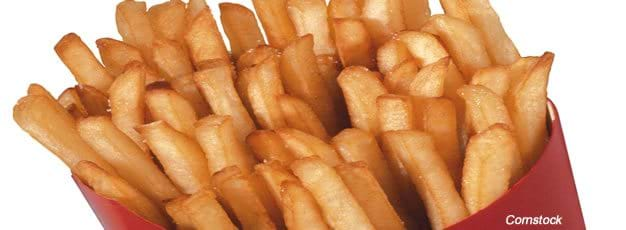Americans Switch From Fresh to Frozen Potatoes

While potatoes have been a mainstay of the American diet for generations, how potatoes are eaten has changed dramatically. In 1960, Americans consumed a yearly average of 81 pounds of fresh potatoes and 7.6 pounds of frozen potatoes, according to ERS’s per capita food availability data, a widely used proxy for actual food intake. In 2004, the average American consumed 46.5 pounds of fresh potatoes and 56.4 pounds of frozen potatoes, mostly french fries. Consumption of potato chips and canned and dehydrated potatoes has remained fairly constant at lower levels.
What has caused the switch from fresh to frozen potatoes? Taste, convenience, technology, and the growing food-away-from-home market all play a role. French fries first became popular in the U.S. when American soldiers stationed in France and Belgium during World War I wanted to continue eating them once they returned home. At first, fresh potatoes were hand peeled, cut into strips, and fried or baked at home or in restaurants.
In the early 1950s, the J.R. Simplot Company developed the frozen french fry—a product that was perfectly suited for the quick preparation needed for the expanding fast food industry. Other innovations, such as curing the potatoes for 3 weeks before frying, improved french fry consistency and quality. Since then, consumption of frozen potatoes has continued to rise, and in 1993, frozen potato consumption exceeded fresh. Almost 90 percent of U.S. french fries were sold to fast food and other restaurants in 2002, according to the American Frozen Food Institute.
The 2005 Dietary Guidelines for Americans recommend eating 2½ cups of vegetables per day for a 2,000-calorie diet, choosing a variety of types of vegetables. In 2004, Americans ate an average of 2 cups of vegetables per day, about 20 percent below recommendations. Variety may be even more of an issue. Potatoes accounted for roughly one-fourth of this amount.
The shift from fresh potatoes to frozen fries poses a dietary challenge for Americans trying to keep their daily intake of calories and fat within dietary recommendations. A 100-gram baked Russet potato with skin has 97 calories and almost no fat, while 100 grams of french fries has over 300 calories and 16 grams of fat. Of course, the dietary impacts of adding sour cream, cheese, bacon, and other condiments need to be considered as well.
Food Availability (Per Capita) Data System, by Linda Kantor and Andrzej Blazejczyk , USDA, Economic Research Service, September 2024


